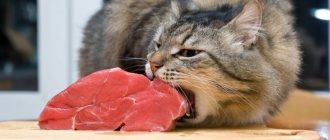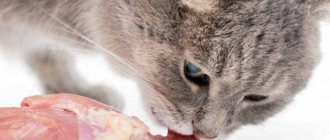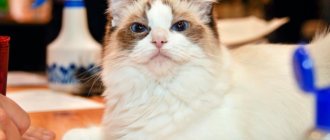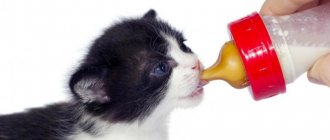About half of the owners feed their cats dry food, forgetting that the original food of predators is meat. In the case of adult animals, this is an acceptable type of feeding, but not in the case of small kittens. The first food they should try after mother's milk is meat, no choice. Therefore, the answer to the question whether kittens can eat meat is a definite “yes.” Now let’s talk about what it should be, how much, when and in what form.
This article is part of the Natural Cat Nutrition section.
Can kittens eat raw meat?
We figured out whether kittens can be given meat. But another question immediately arises: can kittens be given raw meat? Let us answer: raw meat is the most appropriate diet for cats, including small ones.
Article continues after advertisement
In this article we will not dwell in too much detail on why raw meat is the mainstay of the diet. This is written about in another article, which suggests going back almost 100 years ago to the moment when a famous scientist conducted a large-scale experiment and found out whether it is possible to feed a kitten raw meat and why it is necessary to feed raw meat to adult cats. In short, it is the unprocessed product that retains all the useful substances necessary for the full functioning of the predator’s body. When cooked, most of these substances are no longer present.
But what if raw meat is dangerous? Indeed, there are helminths and infections in it... We answer.
To get rid of helminths in meat, which actually sometimes exist there, you need to freeze it in the freezer for at least three days at a temperature of -18 degrees Celsius or lower. Although, it is worth noting that on cattle farms or poultry farms they constantly carry out prevention by giving animals anthelmintic drugs. Therefore, finding viable worm eggs in industrial meat is a great “luck”.
As for microbes, the predator’s body copes with most infections that usually occur in meat without problems due to the very acidic environment of the stomach. Cats, for example, do not even get sick from salmonellosis, except perhaps weakened individuals and those who have problems with the gastrointestinal tract. But in any case, meat must be purchased in supermarkets, specialized warehouses or certified market points. No products from private owners!
Why do cats need meat?
The cat's ancestors were wild, forest animals that by nature loved to hunt. Otherwise, there was no way to survive in the dense forest. The cat's body easily digests raw game, including small bones. Cats digest everything that their digestive system is “programmed” for: mice, rats, birds, lizards, insects and all their small brothers. Domestic cats living in the village enjoy practicing their hunting skills and feasting on their prey in the summer.
The cat's body is adapted to the following operations:
- tear prey to pieces using sharp fangs and strong jaws;
- swallow meat in large portions , due to the elasticity of the esophagus;
- accommodate large volumes of swallowed meat, which are easily moved into the stomach with the help of mucus specially produced in the esophagus;
- digest meat masses and their proteins with the assistance of gastric enzymes - pepsins.
In addition, the cat’s body desperately needs all the beneficial substances that meat is rich in. It doesn’t matter whether it’s a street cat or a house cat – the digestive organs will not adapt to a different type of food. Of course, a cat can eat vegetables, cereals and fish, but then the body will experience a lack of useful elements. Such a pet will not be healthy and cheerful.
Therefore, meat should be the main and regular dish in a cat’s diet if the owner feeds the pet natural food. A full range of essential valuable substances is contained in premium dry and wet food. And forget about cheap “bags”! Feeding a cat economical commercial food is like feeding it paper or clay.
Can kittens have boiled meat?
Does a kitten need to cook meat? No no need. He, being a predator, does not need this. Yes, the kitten looks weak and fragile. But that's what you think until you put a piece of raw meat in front of him.
And, nevertheless, kittens can also have boiled meat, it is not poison. However, such nutrition has a number of disadvantages. Firstly, it, as we have already written, is almost completely devoid of useful substances. On a boiled diet, a kitten has to add special vitamin and mineral complexes to its food, which are expensive and often do more harm than good. Secondly, boiled meat is dehydrated, meaning that eating it in large quantities creates a risk of constipation. Thirdly, it is raw fiber that helps adjust the kitten’s digestive enzymes in the right way.
Well, if you only occasionally want to treat your cat to a piece of boiled meat, that’s okay. The main thing is that the basis of the diet is raw.
Cat diet rules
Everything that is given to the pet on the “table” must be exclusively fresh, otherwise severe poisoning or indigestion is not far off. And don’t believe stories that all cats are naturally immune to infections from meat or fish. Even if you are completely confident in the purity of the purchased meat (“from your hands”), it may still contain helminths, parasites and their larvae.
In order not to guess with chamomile whether your pet will be poisoned or not, just buy the meat in advance and freeze it in the freezer for 2 days. Before freezing, it is advisable to cut the meat into pieces so that for defrosting you can get the required number of pieces, and not the whole huge chunk. All parasites will die from frost, and fresh meat will retain its beneficial properties (more than half of the valuable substances are destroyed during cooking).
There is no need to cut the meat into too small pieces. Nature is cunning and thought of everything in advance. Cats really like to tear meat into pieces themselves, and at the same time their gastric juice is secreted more intensely, which promotes better digestion. To be extra cautious, you can add 3-4 drops of olive oil to the meat - it will be better absorbed.
Among cats there are strange individuals who refuse raw meat. In such cases, you need to scald the pieces with boiling water or cook in a saucepan for 3-5 minutes. Cats should not salt their food.
A pet needs 200 grams of food per day; it is recommended to divide it into 2 feedings of equal volume. Each serving contains 75% meat and 25% boiled vegetables. The meat diet should be varied, periodically including poultry, fish, and offal. Many owners, in a thirst for savings, try to feed their cat only offal, but this cannot be done. The share of offal in the pet's daily menu should be 1/5 of the rest of the food. It is also necessary to ensure alternation: kidneys on Monday, heart on Tuesday, and so on. Be careful: some offal products can cause stool disorders in a cat and will need to be excluded from the diet.
At what age are kittens given meat?
When should kittens be given meat for the first time? Complementary feeding begins at approximately 3-4 weeks. At this time, they still eat their mother's milk, but they are already trying adult food. The ideal option is to give the children the same thing as the mother if she is a raw foodist. If she eats industrial food, then the kittens are given a separate bowl of meat. Babies always need to start digestion, starting with raw meat.
Article continues after advertisement
The editors of the Murkotiki website often receive questions about problems with the gastrointestinal tract caused by improper complementary feeding. Many insufficiently competent breeders, unfortunately, give kittens porridge with boiled meat and immediately offer dry food. This almost always leads to small (unnoticed by the owner) or even big problems. Food can be added to the diet when the kitten already knows what meat is.
Just look at how this little predator eats raw meat! Watch with sound.
Compatibility of raw and cooked product
Sometimes owners of furry cats give them boiled meat. Many cats use it more readily. It is also saturated with a large number of useful minerals, micro- and macroelements, so it can be included in the menu.
My only wish is that you cannot combine boiled and raw in one serving. When a cat eats a raw and cooked product at the same time, the action of 2 different enzymes will be needed to digest them. This causes the digestive system to malfunction in animals.
In weakened individuals, such combined feeding can cause diarrhea, constipation, vomiting and other dyspeptic disorders. To avoid such problems, it is recommended to maintain at least a three-hour interval between feeding raw or cooked meat.
It is advisable to give boiled meat to your pet if there is a risk of parasite eggs entering its body; moreover, it retains all the beneficial properties and ingredients. It is not recommended to add salt to cooked foods, as it causes great harm to the cat’s body.
When to give raw meat to a kitten?
Raw meat can be given to kittens from the age of 3 weeks, and by 2 months all babies should already be able to consume this product. Raw fresh meat is served to kittens after at least three days of freezing. Next, the product must be defrosted and waited until it reaches room temperature.
Meat can be given at once in large pieces, which the kitten is guaranteed not to swallow. Thus, by tearing small pieces from one large piece, the kitten will train its jaw muscles, brush its teeth and realize its predatory instinct.
You can also cut the meat into small pieces: they are quite suitable. The very first feeding can also be in the form of minced meat. But there is no need to give minced meat or pate all the time: the fibrous structure of the meat has already been damaged in minced meat, which because of this becomes less useful, because passes through the gastrointestinal tract faster and is absorbed worse.
What by-products can cats eat?
By-products (offal) are internal organs and less valuable parts of carcasses, which is why they cost less. But by-products have different nutritional and taste value, so they are divided into categories. For example, the liver or tongue is in no way inferior to meat, while the lungs and trachea are depleted in microelements and are not as tasty.
| BY-PRODUCT | DESCRIPTION |
| HEART | Pork, beef and poultry hearts are an excellent source of protein and taurine. Pork or turkey are the most useful. Beef is harder to digest, but it is very nutritious. The heart contains large amounts of taurine, an acid essential for the heart of cats. The share of the product in the total diet can reach up to 40%, because its protein is absorbed no worse than meat. |
| LIVER | Liver should make up no more than 5% of a cat's diet, because... it weakens and can cause hypervitaminosis with vitamin A. However, cats need this vitamin, and they do not absorb it from carrots, so it is useful to include liver in the diet. But it is advisable to serve it not separately, but as part of mixes. |
| STOMACHES | It is a source of protein, vitamins and beneficial microflora. The share in the total diet can reach up to 40%. |
| NECK, CARTILAGE | The spine, neck cartilage, scallops, and backs of poultry are sources of calcium and collagen. Also, when eating bones, a cat cleans plaque from its teeth. But bones must be given according to special rules and only to animals that are able to digest them. Otherwise, it is better to choose dietary supplements with calcium. |
| HEADS | Chicken heads are a good source of calcium. While eating the heads, the cat cleans its teeth of plaque and strengthens its jaw muscles. The brain and eyes are extremely useful because they contain fatty acids and a whole vitamin and mineral complex. In addition, cockscomb is a source of collagen. |
| LANGUAGES | Tongue has a high nutritional value, although its protein is not as well absorbed as, for example, heart protein. Tongues also contain valuable collagen. However, they lack a number of essential amino acids, so tongue cannot be the main part of the diet. |
| LUNGS | Lungs have low nutritional value, but they are a good source of cartilage tissue, which is very useful for kittens during the period of active growth. However, the lungs have a large preponderance of phosphorus and at the same time little calcium, so they can only be added to the diet little by little. They cannot be made the basis of the diet. |
| KIDNEYS | Kidneys are a source of proteins, which, however, are absorbed worse than muscle meat proteins. The kidneys are very rich in vitamins, therefore they have high nutritional value. But they have a specific smell of urine, so most cats refuse to eat this offal. |
| SPLEEN | A product that may be present in a cat's diet in small quantities. Spleen is not as poor in nutritional value as some organ meats, but can cause loose stools and even intestinal upset. It, like liver, is best used only as part of mixes. |
| TESTS | Bull testicles are considered a delicacy. They contain quickly digestible protein and are very nutritious (20% fat). Bull testicles are rich in B vitamins, potassium, calcium, magnesium, zinc, sodium, phosphorus and other microelements. They contain hormones, which is why some consider them beneficial for breeding cats. |
| UDDER | It is a fatty and high-calorie product, but it contains mostly incomplete proteins, so it can be added to mixes only in small quantities, and in no case should it be made the basis of the diet. The udder also contains milk, so cats with lactose intolerance may become bloated and weak after milk. |
| SCAR | Cats usually don't like the stomach of a cow, because... it smells like manure. But there are gourmet cats who eat tripe. This part is a source of healthy microflora for the stomach. It is also quite nutritious. But be careful. In the rumen you can find dangerous objects eaten by the cow during its lifetime: the fish is washed before sale, but it is better to double-check it at home. At the same time, a washed scar is almost useless in terms of microflora. |
By-products need to be combined: then the cat will get everything it needs. There is an opinion that the proportions of by-products should be selected so that the quantity of each of them corresponds to the proportion of the same organ in a mouse - the natural prey of a cat. But for this you will have to run around with kitchen scales, which is inconvenient. Another thing is important: a cat can easily digest and assimilate both the stomach, the heart, the liver, the kidneys, and other organs, and meat, i.e. There is no need to specifically separate them for different feedings. Or you can give it in turns: one product at each feeding. But we remember that it is recommended to give liver and spleen only as part of mixes.
In general, natural nutrition is good because the same microelement can be contained in different products, so owners are free to select them at their own discretion, creating countless combinations.
How much meat should I give my kitten?
Raw meat for 1 month old kittens is served in a bowl directly into the nest. The mother eats the same food as her kittens. They look at their mother and learn to do everything right. The lactating female is not limited in food: she is allowed to eat several times a day. Let mom eat enough. And kittens will not eat too much meat, because... their main food is still milk. Meat in this case is just training for now.
Raw meat for kittens at 2 months already becomes a complete meal. At this time, they switch to their own provision, gradually abandoning their mother's milk. At this time, the breeder feeds them either natural food, industrial food, or a mixture. Many breeders prefer the mixed version, because... It is unknown what exactly the kitten will eat in its new home. If this is a different type of feeding, then he may develop digestive problems - and the buyer will file a claim with the breeder.
EXPERT COMMENT: CANDIDATE OF BIOLOGICAL SCIENCES GALINA CHILIKINA
“If the nursery fed only one natural female, and the new owners want to switch it to dry food, very serious digestive problems may arise, since aggressive enzymes will be released with the gastric juice, necessary for digesting meat, which are not needed for drying. If, on the contrary, the kitten in the nursery was fed exclusively dry food, and its new owners want to switch it to healthy natural food, the kitten will experience a phenomenon such as an inability to digest this food, since the stomach does not produce the enzymes necessary for this, so the kitten will constantly regurgitate this food, which may be perceived by the owners as a pathology. Diarrhea and other phenomena are also possible.”
Raw meat for kittens at 3 months is already the main food. From 3 months, most have lactose intolerance: due to the large amount of milk, pets can become bloated and diarrhea.
Article continues after advertisement
Small kittens are not limited in the amount of food they eat, giving meat several times a day. But you shouldn’t let them eat a lot at one time. The daily dose is approximately up to 10% of the kitten’s body weight.
At 3 months, many kittens already find a new home, and owners cannot always feed them several times a day. In this case, it is not necessary to switch to dry food, which is always available. A three-month-old kitten can already be fed raw meat like an adult animal: twice or thrice a day, also in a total amount of up to 10% of body weight.
For more information on how often to feed raw meat to your kitten, follow this link. The article indicates feeding standards for Scottish kittens, but the feeding principles described are valid for any breed.
How and how much to give?
Veterinarians do not recommend buying a turkey sealed in a vacuum bag, since pathogenic microorganisms multiply quickly in a humid environment and there is a high probability of buying a spoiled product.
Chicken can diversify your pet's meat diet.
The optimal amount of meat product is calculated based on the weight and age of the pet. However, the standard single portion is 30-35 g. You should not give your cat turkey every day, it is better not more than 2 times a week. Felinologists recommend alternating this type of meat with chicken and beef. To avoid the risk of parasite infection, you need to feed your cat boiled turkey meat. It is acceptable to give raw products if they have been stored in the freezer for 1 week before.
For kittens under 1 year of age, the meat should be boiled and pureed. It goes well with stewed vegetables, which will balance the animal’s diet. There is no need to fry or add oil to the turkey. It is important to remove all small bones, especially if the bird has been heat-treated. If a cat swallows a splinter, it can be fatal, especially in a kitten. With great caution, it is permissible to give large bones that the pet cannot swallow. Turkey allergies typically include rashes, scabies, and hair loss. If such symptoms appear, the bird should be removed from the menu.
What kind of meat should I give to kittens?
Now let's move on to the question of what kind of meat can be given to kittens. Different types of meat are acceptable. It is variety that allows you to make the diet as healthy as possible and not boring for your cat. However, if it is possible to feed only one type of meat and the kitten is not allergic to it, you will have to feed only one.
Chicken meat for kittens
Chicken meat for kittens is a good option. But the answer to the question whether kittens can eat chicken is ambiguous. Chicken itself is a healthy meat, easy to digest and in all respects ideal for starting complementary feeding. However, chicken is not always environmentally friendly: often the meat is soaked in harmful solutions to maintain freshness. Nutritionists also have complaints about the keeping of animals in some poultry farms. Because of all this, many pets have a negative reaction to chicken, or rather, not to the chicken meat itself, but to what it is stuffed with.
The conclusion from here is this: look for a reliable supplier whose chicken does not smell of chemicals, and whose birds are kept in normal conditions. A cat should eat such meat with pleasure, and not turn up its nose. And after the meal there should be no negative reactions: diarrhea, rash, watery eyes, etc. If there is a reaction, you will have to either change the supplier, or if this is impossible, completely abandon chicken in favor of turkey.
Turkey meat for kittens
Turkey is a fairly dietary meat, similar in composition to chicken, but more environmentally friendly. Therefore, it is ideal for feeding your pet, unless, of course, he is allergic to turkey. Turkey is the number two choice, if not number one, when deciding what meat to feed your kittens.
The breast is the least valuable part of the turkey and cannot be the basis of the diet: it does not contain enough fat that cats need so much. But at times when the cat needs to be kept on a gentle diet (for example, after an illness), you can choose the breast. On other days, kittens can easily eat the legs (the fatty parts from under the tail must be cut out).
Duck meat for kittens
Goose meat is quite tough and lean, but duck is fatty, so it is better not to use its skin and subcutaneous fat in feeding kittens. Fortunately, this fat is easily removed - and what remains is excellent meat rich in vitamins and minerals. The best options for duck are the thighs and breast.
Read more about these and other types of meat in the separate publication “What Meat to Give to Cats.”
Article continues after advertisement
Benefits and harms
Veterinarians recommend weighing the following pros and cons presented in the table before including turkey meat in your cat’s diet:
| Positive characteristics | Negative consequences of use |
| High protein content | Excessive fat content in the skin |
| Low levels of dangerous fats | Risk of parasite infection due to insufficient heat treatment |
| High concentration of taurine | Possibility of poisoning with nitrates and antibiotics |
| Quick saturation of the body | High content of dangerous long bones |
| Minimal likelihood of allergies | Spoiled turkey causes gastrointestinal upset |
Possible problems
Sometimes kittens have problems when feeding meat. Let's list the most typical ones.
Kitten vomits raw meat
If a kitten vomits raw meat, then most likely he ate too much at one time. Some kittens do not know how to control their eating behavior, attacking food like crazy and eating everything they see. Such kittens should be limited by giving food in strictly measured portions. Even if it seemed to you that the kitten vomited after eating a small amount of meat, perhaps you were just measuring by eye and that’s why its portion seemed small. So use a kitchen scale.
Also, the cause of regurgitation may be intolerance to any type of meat. Pay attention to what exactly the kitten regurgitates. If it is always the same type of meat, you will have to give it up.
In addition, regurgitation of hard food such as gizzards or bones may occur.
In addition, if the kitten is 2-3 months old or more, and he is accustomed only to industrial food, problems associated with enzyme deficiency may arise with the consumption of meat.
EXPERT COMMENT: CANDIDATE OF BIOLOGICAL SCIENCES GALINA CHILIKINA
“Any dry food is granules that have a porous structure and contain almost digested food, so enzymes are not required to digest dry food. Entering the stomach through the esophagus, these granules begin to absorb gastric juice, under the influence of which they turn into a homogeneous liquid gruel, which in turn enters the small intestine, where absorption occurs. The movement of this liquid gruel from the stomach into the intestines occurs almost by gravity, so contraction of the walls of the stomach and intestines is not required. Therefore, the motility of the gastrointestinal tract in cats eating exclusively dry food is very sluggish. Thus, dry industrial food takes over the functions of the body, and this leads to the fact that the cat does not produce enzymes intended for breaking down and digesting natural food.”
Kitten eats only meat
This is normal, no need to worry. The kitten is a predator, it is supposed to eat meat. All other products (fermented milk, fish, vegetables, eggs) are food additives that may not be in the diet. And even more so, do not feed kittens cereals that are harmful to them.
Kitten doesn't want to eat meat
But this situation, on the contrary, requires careful study. All kittens, when they reach the age of 1 month, are already able to absorb some amount of meat. After all, at 2 months they will have to wean themselves from their mother’s breast and eat on their own. If a very small kitten refuses meat, then it is simply too early for him to eat it. If we are talking about a 2-month-old kitten, then it needs to be examined. Typically, this behavior is associated with gastrointestinal pathologies.
Some cats refuse to eat meat if they have been taught to eat dry food. Adult cats can sometimes be very difficult to retrain. But with kittens that previously ate dry food, as a rule, there are no problems when switching to meat. Kittens are open to everything new and it is quite simple to form in them the food preferences needed by the owner.
Composition of turkey: why is it so healthy?
Poultry contains almost no fat and cholesterol, which are dangerous for pets, and is also rich in the following beneficial elements:
The optimal level of hemoglobin in the animal’s blood can be maintained by iron, which this product is rich in.
- Retinol. The vitamin enhances the animal’s natural immune defense, prevents pathologies of the visual apparatus and stimulates tissue regeneration.
- Tocopherol. A natural antioxidant prevents disturbances in the functioning of the pet’s reproductive system and improves overall well-being.
- Cu and P. Microelements strengthen bone tissue and dental apparatus.
- Polyunsaturated fatty acids. Omega-3 and 6 improve the condition of the coat and skin.
- Fe. Iron supplied from outside maintains normal hemoglobin levels in the blood.
- Taurine. Sulfonic acid, which the cat’s body cannot synthesize on its own, supports the normal functioning of the visual organs.
Can a cat eat beef after heat treatment?
It is widely believed that raw meat is harmful to animals due to the risk of infection by helminths and bacteria. Many owners, breeders and even veterinarians still advise processing meat before putting it in a cat's bowl.
Processing is reduced to scalding with boiling water or boiling the beef. However, scalding does not make any sense at all - such a superficial temperature effect is not capable of killing bacteria, not to mention helminth eggs. Boiling meat may be appropriate if you suspect that it is contaminated, that is, it was obtained from a sick animal.
The veterinary inspection that every cow carcass that goes on sale is subjected to virtually eliminates contamination of the meat. A cat may like boiled beef less than raw beef, and there will be less valuable substances left in it. Thus, temperature treatment is not at all necessary.
Beef is an excellent source of protein and fat when feeding cats whose owners prefer to feed at home. But you cannot give an animal only meat; the diet must be tailored to all the needs of the animal and must contain other products and additives.
How to keep meat safe
Bacteria, parasites, and viruses die at high and low temperatures; to reduce the risk of infection, the following methods are used:
- Freezing. In home refrigerators, at minus 18℃, parasites die in 4 days. This does not apply to trichinella and salmonella; frost does not affect them.
- Cooking. In boiling water, viruses and bacteria die within 1 – 20 minutes; it will take 3 hours to destroy Trichinella.
When scalded with boiling water, bacteria are destroyed from the surface; this method will not protect against helminthiasis. Meat is not kept next to other food; a separate knife and cutting board are allocated for it.
To prevent your cat from becoming infected with worms by eating meat, the product must be well prepared beforehand. The owner won’t have to do anything complicated. In order to destroy parasite eggs, their larvae and even adults, it is enough to freeze the meat for 50 hours. No matter how resilient worms are, they cannot withstand prolonged exposure to sub-zero temperatures. After cooling, the meat becomes completely safe and can be given to your cat without worrying about its health.











